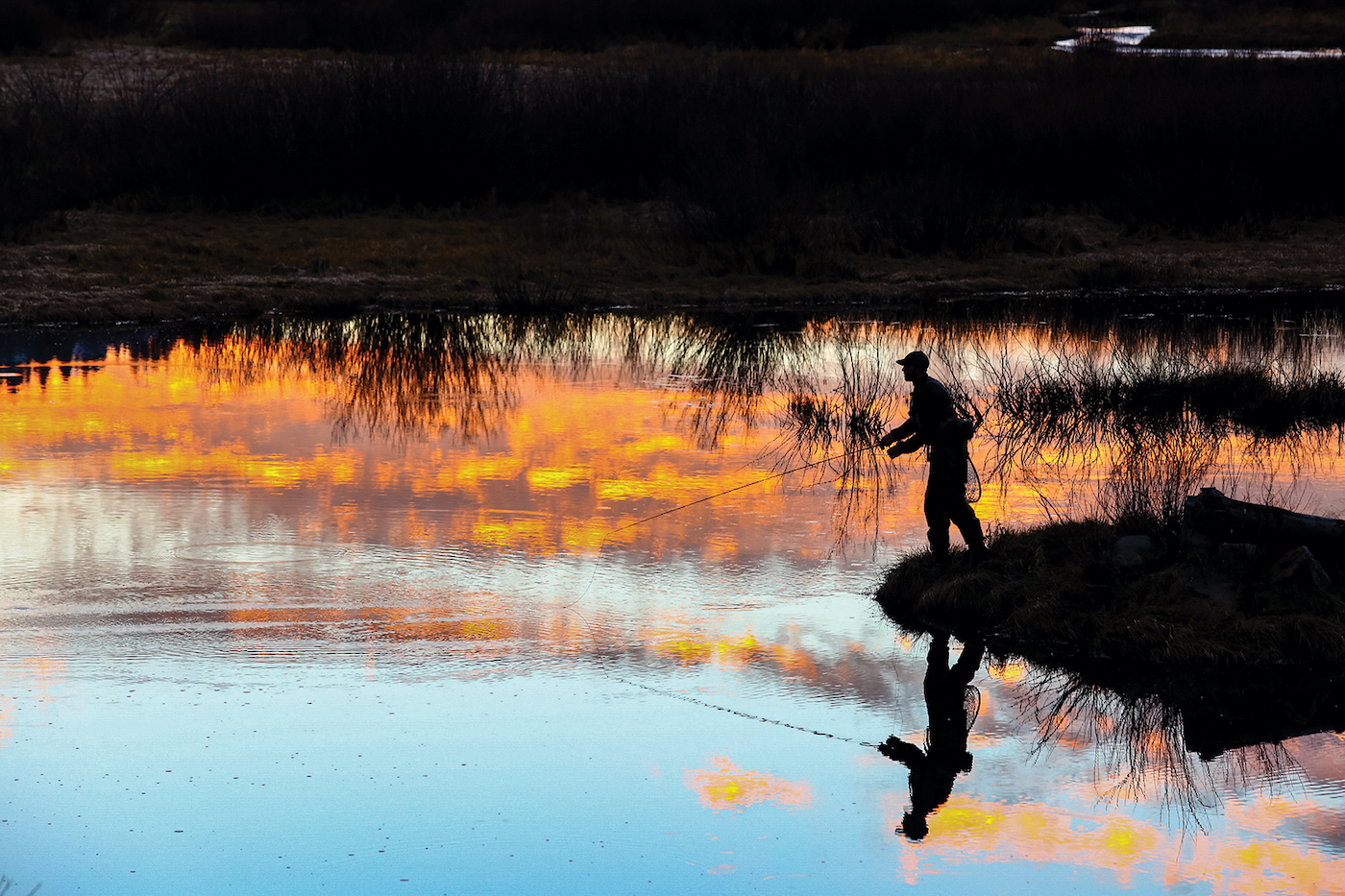
25 Jun Success on the Fly
A pandemic-driven surge in fly-fishing has created opportunity in the Tahoe area, where an increase in anglers indicates growing interest in the sport—as well as more pressure on local waters
The rod moves like a windshield wiper on a drizzly day, tracing wide arcs over the Truckee River as Jeff Sasaki points the tip upstream toward Lake Tahoe, then downstream toward Lake Pyramid, then back again. The physics at play in getting his fly between two pale boulders where a rainbow trout may be hiding—involving potential and kinetic energy, air resistance, surface tension, turbulent versus laminar flow and who knows how many more textbook terms—may be nearly as complex as the rights governing the highly contested water that runs through California and into agricultural fields and kitchen sinks in Nevada.
The fish, however, care nothing about politics or treaties or the obligations of Lake Tahoe’s water master. Pioneers and partisan bickering in congress? Dams and diversions? The myriad machinations that have routed and roiled the river for more than 150 years and seek to shape its future course? None of that occupies the rainbow trout, which itself is the beneficiary of stocking efforts that introduced non-native salmonids to local waters depleted of their natural cutthroats. Various historical acts and policies may have benefited or harmed their collective numbers, but to a single fish, just about the only things that matter are spawning and—more frequent and pressing—finding that next meal.
In mid-spring, lunch for a speckled and shimmering Oncorhynchus mykiss could be any of a number of aerial and aquatic creatures: an algae-fed mayfly, perhaps, fluttering under wings like leaded glass panels, or a stonefly larva, all segmented, symmetrical and scuttling, like something out of a 1950s science-fiction matinee.

Jeff Sasaki in action on the Truckee River, photo courtesy MAVRK
Sasaki hopes that at least one hungry trout will go instead for an artificial but appetizing substitute, an assemblage of beads, fibers and feathers fashioned to resemble something tasty and alive.
“Your flies are like your puppets,” he says, “and you’re the puppeteer.”
Hence the careful casting, ticking his rod back and forth like a metronome marking the time until he flicks his wrist and sends the faux fly into the precious liquid decanted by Lake Tahoe from the Sierra Nevada snowpack.
He has two targets to consider in the moment: where the fly enters the water and the zone where the fly will pass, where he thinks the fish are lurking. He likens nailing the timing to simultaneously patting your head and rubbing your stomach. It’s difficult to coordinate the disparate actions at first, but once you get it, you get it.
Hopefully—if his mental calculations, intuition, muscle memory and situational adjustments synch up as intended—the fly will sink to an ideal depth, wiggling in the most alluring way as to catch the discerning elliptical eye of the theoretical trout.
Beyond the moment, however, the product designer has a larger goal: to propel the sport of fly-fishing forward by making gear that is lighter and well-suited for longstanding European techniques that are beginning to catch on in the United States. Sasaki developed a device, dubbed the “Stinger,” that replaces the reel on a rod, shaving ounces off the total rig to make it that much easier to hold up and out for hours.
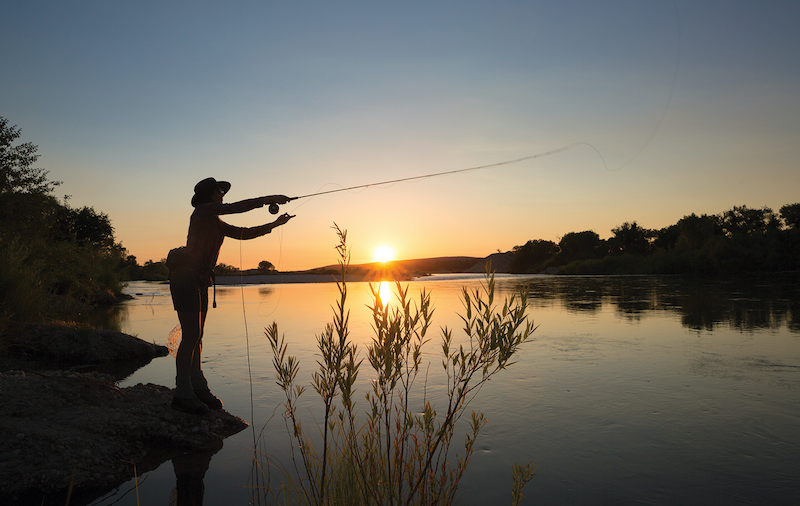
Chelsea Baum fly-fishes along the South Yuba River, photo by David Braun
A Pandemic-Fueled Popularity Boom
This is the time for such endeavors. The California Department of Fish and Wildlife sold more than 1.1 million annual sport fishing licenses to state residents in 2020—184,501 more than the year prior and a high for the last decade, which saw licenses dipping into the 900,000s for several years. The total annual licenses sold so far for 2021 (as of May 31) was 843,508.
By all accounts, the pandemic is to thank for the jump. Telling people to stay away from businesses and public areas—from other people, as a whole—makes for a good excuse to get out into nature, where social distancing is pretty much a given.
On a local level, anglers in the Tahoe area anecdotally confirmed increased interest in the sport, with some saying fly-fishing recently saw its biggest bump since a 27-year-old Brad Pitt grinned his way across rural Montana and onto the A-list in 1992’s A River Runs Through It.
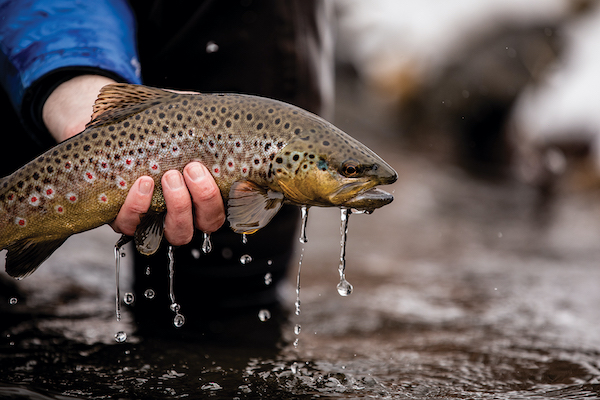
A Truckee River brown trout prepared for release back into the river, photo by Scott Keith, courtesy Trout Creek Outfitters
“As we saw last summer, the pandemic spurred many people to escape the contagion by heading to rural areas like Truckee and Tahoe, which in turn spurred an explosion of interest in outdoor activities, including fly-fishing,” says Richard Anderson, former Truckee mayor and founder of the almost 30-year-old California Fly Fisher magazine. “This was, of course, a welcome boost for an economy that was otherwise suffering from the restrictions needed to control the pandemic, but our local fisheries were at times overwhelmed with anglers, as well as trashed—literally.”
James Donahue, a 37-year-old Truckee real estate agent who enjoys fly-fishing two to three times a week, agrees.
“It kinda got busy the moment quarantine went into effect,” he says. “It’s been amazingly crowded. It just boggles the mind.”
Donahue wryly admits that his definition of “amazingly crowded” may skew a bit isolationist: “If you see somebody, that’s crowded for me.” Fortunately, there’s a lot of space along the Truckee River’s 120 miles, so when he spots another angler, he simply walks until he’s alone again.
“We’re not here to hang out with our fellow man,” says Donahue. “We do that in other places.”
One such place is Tahoe Fly Fishing Outfitters in South Lake Tahoe. Victor Babbitt’s shop has geared up anglers, offered patient instruction to newbies and led guided trips to “five watersheds within a three-hour circle”—the Truckee, Carson, Walker and, on rare occasions, American and Yuba rivers—since the mid-1990s.
“We got slammed last year. Once we opened back up [after pandemic closures], we did our biggest year ever,” Babbitt says. “Our equipment and retail increased almost twofold.”
The momentum has carried into this year, with spring’s sales more closely resembling the sorts of numbers Babbitt typically sees in the summer, when more people are out angling.
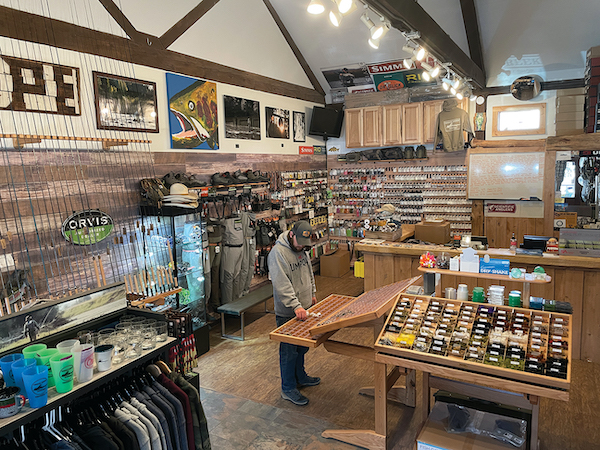
The interior of Trout Creek Outfitters, which opened in downtown Truckee on Father’s Day 2020, courtesy photo
“We’re anticipating that it’s going to be, once again, over the top,” he says, though he notes that he won’t be around much longer to see it happen in person. Babbitt has sold his shop and is moving to Montana this summer in celebration of entering his 60s—and, presumably, fly-fishing worthy of Robert Redford’s cinematic vision.
Another, newer space to congregate apart from the river is Trout Creek Outfitters, a fly-fishing shop that opened in downtown Truckee on Father’s Day 2020 and quickly became a go-to resource for area anglers. One of the shop founders, Miles Zimmerman, moved from the Bay Area to Truckee “for the powder” in 2007, but picked up a rod and learned how to wield it about two years later.
“I don’t really ski anymore,” Zimmerman says. “All I do is fish.”
He worked for six years at Truckee’s Ace Mountain Hardware & Sports, the last two of which he served as head of the fishing department. But after numerous conversations with anglers who wondered why Truckee didn’t have a dedicated fly-fishing shop, he decided to open his own. He partnered with Scotty Koper, who worked at the hardware store in the summers, and Scott Ferguson.
Zimmerman is quick to compliment Mountain Hardware & Sports, noting their good selection and knowledgeable staff.
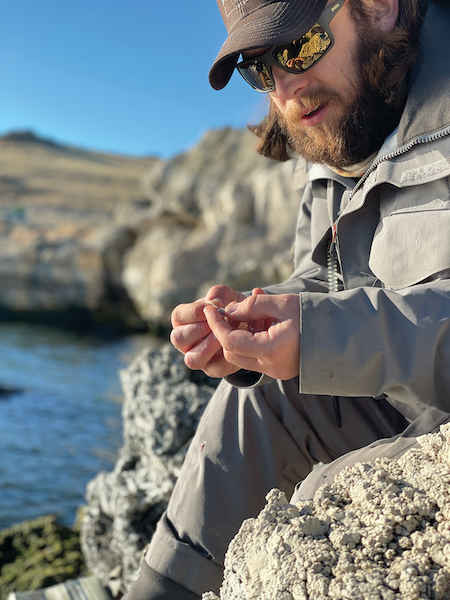
Miles Zimmerman of Trout Creek Outfitters prepares a fly for Pyramid Lake, photo by Scott Keith, courtesy Trout Creek Outfitters
“But … eventually you need to have a true-deal standalone fish shop in a [mountain] town,” he says.
Economic challenges created by the pandemic proved to work in the fledgling shop owners’ favor, opening a space they might not have been able to occupy or afford under different circumstances. COVID has also lured more people outside, Zimmerman adds, echoing his fellow anglers’ observations.
“People have all this newfound time on their hands,” he says. “They want to get outdoors and, you know, do something new. … It’s been a very popular hobby [and] a great time to open the business. It’s been very successful thus far, which has been amazing. I’m living a dream.”
That dream also includes the fact that Zimmerman submitted a fly pattern to one of the top fly manufacturers in the country—fly-tying is a whole subset of the sport that could fill an article of its own—and recently learned that they would like to include his design in their spring 2022 lineup.
Zimmerman’s shop itself is both cozy and open, featuring a whiteboard detailing river conditions, current bugs populating the waters and other info in orange dry-erase ink. A stack of Anderson’s California Fly Fisher sits near the register, and wide trays packed with hundreds of Muppet-like minnows, rubbery leeches, elk-hair caddis flies and abstract “flashabou buggers” sit under ceilings high enough to accommodate the towering rods that stand against the wall, their straight lines like the inside of a grand piano.
Between the rods and a rack of hanging waders stands a display of traditional reels and a single Stinger, Jeff Sasaki’s modern reel replacement. This is the high-end model made of machined aluminum, but there’s also an everyday injection-molded version that costs about a third as much.
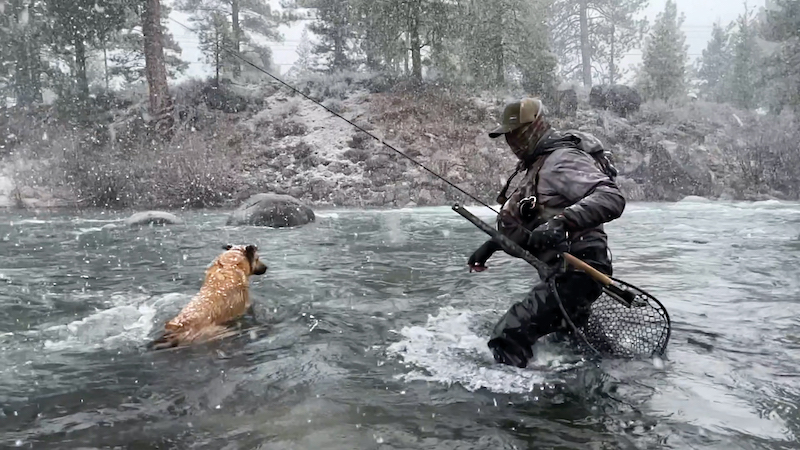
Jeff Sasaki and his four-legged pal, Winston the Amazing K9, brave the snow to get in some casts on the Truckee River, photo courtesy MAVRK
Embracing Innovation
The Stinger represents something of a rebirth for Sasaki, who, after a career spent designing protective gear for cycling and other action sports, moved with his wife from San Diego to their second home in Truckee in 2016 (he also started and sold a company that manufactured iPhone cases from exotic materials). Once settled in,
he didn’t want to do anything but “ride and fish” for a couple of years.
After 400 days of fishing, spread out over those two years, Sasaki realized that the only thing he truly wanted to do, work-wise, was improve every piece of fly-fishing gear he owned.
He started with the reel, aiming to create a device that improved his rod’s efficiency and allowed him to “fish longer and catch more” without adding to the shoulder and back strain common to the sport. Starting with a 3D-printed prototype, he took the design through 100 iterations, tweaking it so it would securely hold the line in place but also allow for the line’s fast and easy removal.

Stinger reels by Jeff Sasaki, photo courtesy MAVRK
Instead of a reel winding the line into coils, the angler keeps the excess line either wound up on the Stinger or floating free, so the current can manage it. On the river, Sasaki demonstrates the Stinger in action, feeding line through his left hand in fluid motions that call to mind milking a cow or stripping corncobs of their silk. The slack forms a wobbly U that slowly unfurls in the water next to his thigh.
The main benefit to this design is the rig’s reduced weight. The Stinger Comp weighs 1.4 ounces, as opposed to a 5- to 7-ounce reel, which Sasaki says improves casting accuracy, reduces arm fatigue and makes the gear more portable.
The fatigue angle, which may sound negligible, is no joke. Sasaki’s preferred fly-fishing technique involves casting upstream, then holding the rod up and out over the water, keeping the tip just ahead of the fly traveling below the surface. It takes about 10 seconds at most for it to pass him to the point where he’s turned 180 degrees, prompting a fresh cast and another slow turn. Repeat. Then repeat again. Seconds add up into minutes, which stack into hours. Taking even 4 ounces off that rod can be a literal weight off a dedicated angler’s shoulders.
In June 2020, just two weeks before Trout Creek Outfitters opened its doors, Sasaki launched a Kickstarter effort that successfully crowdfunded more than $10,000. Stingers went out to backers in August of that year, and he’s since focused on developing the brand, messaging and marketing for his business, MAVRK.

Greg Dering with a colorful rainbow trout caught using Truckee resident Jeff Sasaki’s innovative new Stinger reel, photo courtesy MAVRK
Euro Influence
The timing of Sasaki’s journey has also coincided with—and was shaped a bit by—the rise in popularity of a niche fly-fishing technique known as “Euro nymphing.” The technique is marked by lighter line, a weighted fly that sinks quickly instead of floating on the surface and colored demarcations on the line itself instead of a bobber—all of which pair nicely with the Stinger design. Sasaki admires Euro nymphing for its simplicity, saying it’s both welcoming to newcomers and satisfying for advanced anglers.
He explains that the U.S. men’s competitive fly-fishing team, seeking to nab an elusive win after years of trying at the World Fly Fishing Championships, began adopting the strategies of their more successful competitors some years back. Various proven methods developed for plucking fish from the waters of Poland, France, Spain and the Czech Republic converged into Euro nymphing, a short-range technique that focuses on the idea that most of a fish’s diet comes from sub-surface feeding. Even a cursory Google search for the term shows that guides, hobbyists and shop owners alike have been talking about Euro nymphing since 2017 and earlier, noting that it is effective for landing more fish in less time and dubbing it a trend as opposed to a fad.
Even so, Sasaki speculates that some longtime local anglers may be reluctant to adopt the style because of an adherence to tradition. Or it could be their allegiance to the idea of American superiority in all things, including a sport that was invented overseas, whether by salmon-seekers in Great Britain or Japanese fishermen enjoying tenkara some 400 years ago—or even ancient Macedonians, as some credit fly-fishing’s origins.
Babbitt of Tahoe Fly Fishing Outfitters says Euro nymphing is “the latest craze, no doubt.” But in his opinion, it’s not true fly-fishing.
“I’m a dry fly guy,” he says, referencing the storied tradition of angling with flies that kiss the river from above and stay at the surface—not sink to resemble nymphs recently washed from a rock. “That’s just who I am.”
There’s nothing better, he explains, than watching a fly drift down the river, then seeing a fish rise up to take it.
“But I’m a snob,” Babbitt says with a laugh.
Anderson is a bit more charitable in his assessment of traditional fly-fishing anglers’ willingness to embrace new technology and techniques. While he notes that the basic combination of rod, reel and line used to cast a weightless fly has been established since the seventeenth century, innovations to reduce weight, increase strength and enhance performance have improved the experience—without rendering “grandfather’s old bamboo and fiberglass rods” irrelevant.
“What I find more interesting is not the evolution in equipment, but changing attitudes in how to use it,” says Anderson. “For a long time, fly-fishers were generalists. We would buy a rod that would work for most types of trout water, typically a 9-foot-long 5-weight, and with it fish dry flies, wet flies, nymphs and streamers.
“Now, fly-fishing for trout is splitting noticeably into disciplines that focus on particular types of rods or gear setups or fishing techniques: two-handed Spey rods and their specialized casts, for example, as well as reel-less tenkara methods, which emphasize simplicity, and Euro nymphing gear and tactics that rely on longer-than-usual rods, fast-sinking flies and extremely thin lines.”
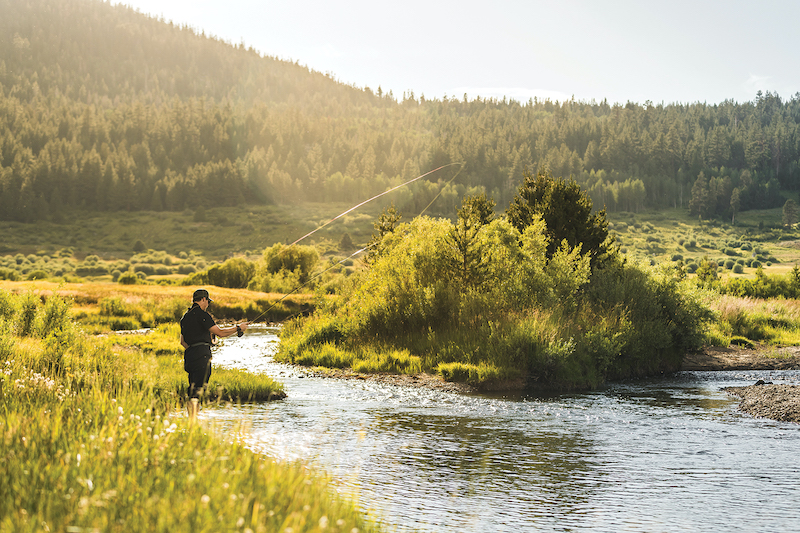
Fly-fishing on the West Fork of the Carson River in Hope Valley, photo by Brian Walker
Stewards of Trout Habitat
As much as innovating gear and adopting overseas techniques may represent the future of the sport in the Tahoe area, anglers need waters—and fish in them—to sustain the activity.
Trevor Fagerskog, a Roseville resident who moved from Truckee in late 2020, is current president of the nonprofit sporting group Tahoe Truckee Fly Fishers and state chair of the California council of the nonprofit conservation group Trout Unlimited.
The latter group’s Truckee chapter focuses on habitat restoration in the Truckee River watershed. Fagerskog reasons that it’s not likely anyone is going to reverse the effects of climate change anytime soon, so they’re working to find natural areas that were modified by humans, then re-creating conditions that make the water more conducive to fish, even in a drought-threatened future.
Take, for example, the places where locals built ice dams in the late 1800s and early 1900s.
“Prior to refrigeration, they would freeze the river by damming it up, and then harvest the ice [in winter] and ship it on rail cars to San Francisco and points east,” Fagerskog explains. “When they dammed these rivers up, it just reduced all the gradient. They pulled all the big rock out of it, and it just creates these kind of barren, featureless areas—long stretches of 1,000 feet or more.”
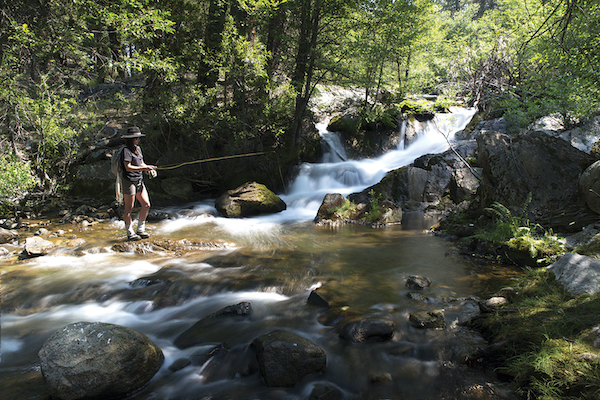
Chelsea Baum fishes a small creek in the Tahoe National Forest, photo by David Braun
While flat, empty pools may be ideal for making ice on the Truckee River, they’re terrible for fish that want deeper crevices where they can hide from predators and the water doesn’t heat up as much when flows are low in the summer.
Trout Unlimited identified several such spots on the Truckee River and has thus far restored two of them, one at Horner’s Corner near Hirschdale in 2017 and one upstream of the wastewater treatment plant off of Glenshire Drive—a spot they affectionately dubbed the “Toilet Bowl”—in late 2020. By installing rock weirs and creating depth, they give trout something more than 6 inches of tepid current to swim in at the peak of the hot season.
As for the Tahoe area as a whole, Fagerskog says fly-fishing is as good now as it’s been in a while.
“I think 10 years ago, it was in kind of rough shape—and the droughts haven’t helped,” he says. “But I think the conservation measures and people being more aware of catch-and-release practices and things like that have helped the fisheries around there.”
It shouldn’t be a surprise that fly-fishing anglers are especially attuned to the conditions of the habitats they frequent. Many study the water, land and air like holy documents, mentally cataloging an encyclopedia’s worth of hyper-local knowledge to give them an edge when they fish. They memorize the life cycles of dozens of types of insects to be sure they know what’s hatching and when and where, judge how river depth impacts water temperature and thereby oxygen levels, and experiment to determine the best flies and techniques for landing fish. Donahue calls it “cracking the code.”
While the sport tends to draw solitude-seekers, they are all connected by the waters they share.
Despite a strict catch limit, depending on the stretch of river, locals generally agree to catch and release only. “I could never imagine taking a fish out of the Truckee River and eating it,” says Scott Keith, who handles marketing for Trout Creek Outfitters and has been working with Sasaki and the Stinger. Area anglers typically abide by the informal “Hoot Owl” closures, as well: “That’s where we all voluntarily stop fishing when the water temperature is 67 degrees, usually around noon in late July and August,” says Fagerskog.
Anderson and Fagerskog also both sit on the Truckee River Basin Water Group, which provides them with knowledge of water releases from dams along the river. An influx from a reservoir can help lower the river temperature, while lack of flow can create situations where fish become stranded in ever-shrinking pools. Being able to anticipate these situations can be critical to the survival of prized wild trout.
“If they cut the flows for whatever particular reason, then we can mobilize a group of people to go out and essentially get buckets of water, put fish in them and move them into an area where the water is deeper,” Fagerskog says.
The Trout Unlimited state chair feels like conservation efforts have lost ground with the recent relaxation of regulations. For example, anglers are now allowed to use previously forbidden barbed hooks—which are more damaging and difficult to remove than barbless hooks, making them deadlier to the fish—and take two fish of any size from the confluence of Prosser Creek to the state line. Other waters in the state moved up to a five-trout limit and no gear restrictions.
The nonprofit uses social media campaigns and works with Forest Service rangers, biologists and wardens to encourage stewardship that takes the future of the river—and the fly-fishing that happens along it—into account.
“One of the things I tried to impress upon the Town of Truckee is that the Truckee River is the crown jewel of that area,” Fagerskog says, noting that with a shrinking shoulder season, influx of Bay Area transplants and other signs of pressure on the watershed, “They’re loving it to death.”
Adds Anderson: “A lot of us understand that this recreational resource, this aspect of the wild world that engages us so deeply, is fragile and facing an increasingly uncertain future due to climate change and growth-related impacts.”
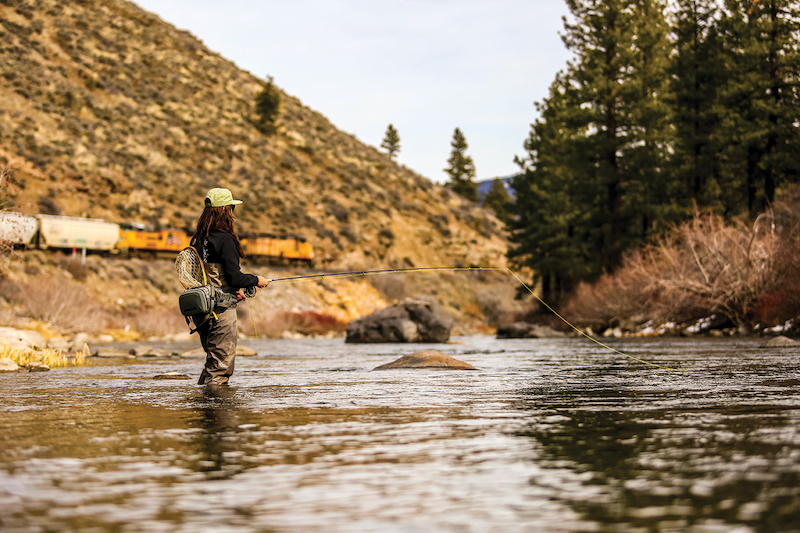
Fly-fishing the Truckee River often includes close encounters with Reno Southern Pacific trains, photo by Jason Shields, courtesy Trout Creek Outfitters
A Sport That’s Here to Stay
What is certain is that as long as there are places where trout gather under winged things that dip and dive, there will be people who want to both care for and catch them.
On a cool spring evening in May, one of those people, Donahue, is returning to civilization after a couple of hours on
the river.
“It was no luck today,” he says over the cricket chorus singing him home. As he walks, wary of his dwindling cellphone battery, he ponders the future of the sport, both in terms of the natural world into which it fits and the people who pursue it.
“I don’t do as much conservation work as I feel like I should be doing because I’m the benefactor of this amazing resource, but it’s something I plan to do more of,” he says. “And I do give a little money to a group that helps out both land and water conservation.”
Does Donahue think interest will continue to grow past the pandemic, once widespread vaccines make indoor activities a viable option again? Yes, he says, especially since it’s such a heavily male-skewed sport. He’s seen women increasingly taking up other sports and hobbies he enjoys—mountain biking and such—so he reasons that fly-fishing shouldn’t be any different. He’s noticed more young people expressing interest, too.
“It’s amazingly beautiful and peaceful to be standing in a river,” he says, “and that’s kind of where it starts. … You try it a couple times, you get frustrated, and then you’ve got to figure it out. And then you’re done. You’re hooked for life.”
Perhaps because of his “hooked” reference, Donahue wants to be sure he’s accurately representing the Truckee River anglers and their commitment to stewardship—to caring for the trout they fight to catch and then gently return to the current.
“You do realize we’re not killing the fish we catch?” he asks. “A lot of people might ask, ‘Well, why are you doing it, then?’
I don’t really have a good answer for that, except that I love these fish, and being amongst them is just really kind of magical.”
Ryan Miller is a writer living in the Sacramento area. Follow him on Twitter or Instagram, @jesteram.




No Comments